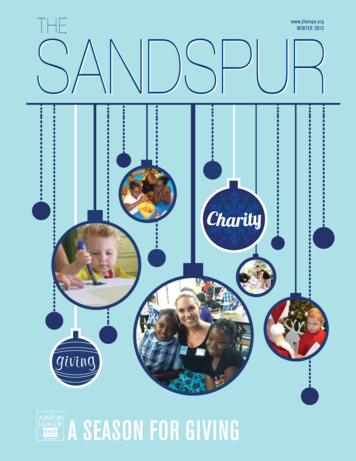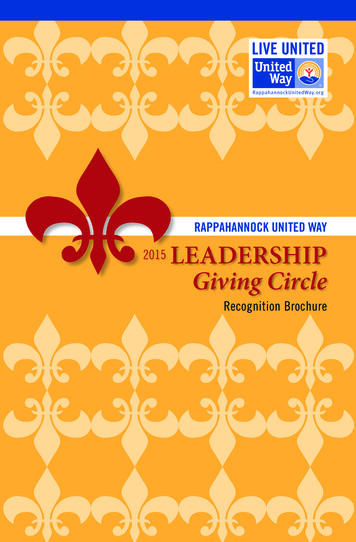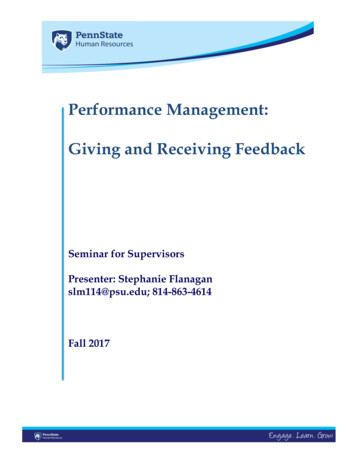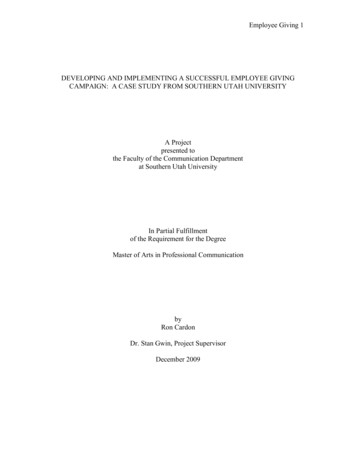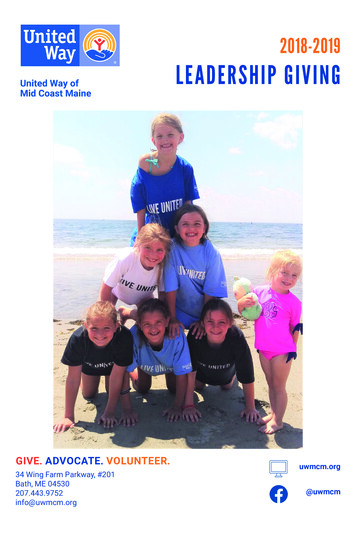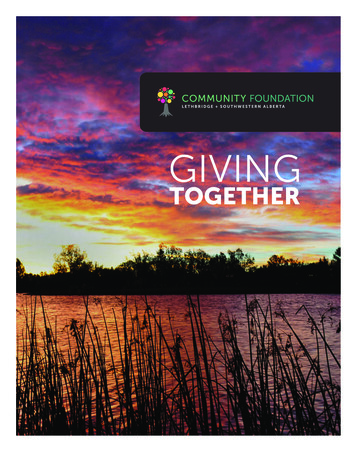
Transcription
GIVINGTOGETHER
Message from the Executive DirectorAssociation (LADA), in partnership with our Community PrioritiesGrants Program. Through our many granting programs, theCommunity Foundation supported Southwestern Alberta withover 700,000 in grant funding in 2017.This past year, we were happy to join community foundationsacross the country and participate in the 150th anniversaryof Canadian Confederation by supporting local initiatives andprojects that inspired a deeper understanding of the people,places, and events that shape our communities and our country.These were projects that encouraged broad participation incommunity and helped build vibrant and inclusive communities.In total, we were able to support eleven initiatives throughoutour region with 70,000 in grants. We were proud to supportLethbridge College’s Founders’ Hall initiative with a Canada150 Grant, an initiative that celebrates indigenous histories andencourages inclusivity on campus. Details about this grant areon the next page. For a complete list of Canada 150 Grants,please see page 10.Charleen DavidsonWelcome to Giving Together, the Community Foundation’sannual report to the community. With this publication, weshowcase our work throughout Southwestern Alberta byfeaturing impact stories about some of the projects our grantssupport. Our hope is that through these stories, you will learnmore about the important work that charities undertake to builda healthy and inclusive community, and how the gifts of ourmany donors transform lives.To truly demonstrate the impact of our donors’ generosity,this year we are pleased to share a list of all of the grants theCommunity Foundation awarded in 2017. We’ve dedicated fourfull pages of this publication to record every grant awardedby each of the Community Foundation’s granting programs:Community Priorities, Henry S. Varley Fund for Rural Life, Youthin Action, Donor-Advised, Donor-Designated, Field of Interest,and Scholarships. In addition, we are pleased to share with youa list of the projects supported by the Lethbridge Auto DealersFor those of you familiar with Giving Together, you will noticethat, once again this year, each story featured in this publicationrepresents one of our six Vital Signs Impact Areas. Beginning lastyear, applicants to our Community Priorities Grants program arerequired to connect their project to our Vital Signs work byidentifying which of Vital Signs’ six Impact Areas their projectaddresses. I’m very happy to report that most applicants wereable to connect their work to at least two Impact Areas, withsome making connections to even more. Through this process,we are able to address strategically the pressing needs identifiedin our community through our Vital Signs report, and, over time,we will be able to track how many projects we have supportedfor each of our Impact Areas.As always, we acknowledge the role that our donors play in ourwork. Because all of our money comes from the generosity ofour donors, our work really would not be possible without them.We are grateful for their ongoing support of the communitythrough our work, and for the gifts that transform lives.Community Foundation LeadershipPresidentGeri Hecker (Lethbridge)TreasurerSteve Miles (Lethbridge)Vice-PresidentRandall Baker (Pincher Creek)Executive DirectorCharleen DavidsonSecond Vice-PresidentDeborah Wescott (Lethbridge)2DirectorsStaffDarren Adamson (Lethbridge)Caitlin GajdostikBruce Anderson (Lethbridge)Rob DowellBjorn Berg (Pincher Creek)Barb Godkin (Milo)Ronda Reach (Fort Macleod)Renee Richards (Lethbridge)Kevin Ronan (Lethbridge)Bob Short (Lethbridge)Laurel Van Vaerenbergh (Picture Butte)
Community ConnectionsArtist William Singer III (Blackfoot nameApi’soomaahka, “Running Coyote”) andShanda Webber unveil Singer’s painting atthe Founders’ Square opening in 2017.Lethbridge College:A Sense of Identity“Education is the new buffalo,” remarks Shanda Webber,borrowing a phrase made popular in recent years that refersto the significance of education for members of Indigenouscommunities throughout Canada. Where IndigenousPeoples once derived sustenance and nourishment fromthe buffalo, they now receive sustenance of a different kindfrom Continuing Education. As Lethbridge College’s Managerof Recruitment and Indigenous Services, Webber’s purviewincludes many students who are in pursuit of this “new buffalo.”Part of ensuring their success is helping to foster a connectionbetween students and their institution, one that celebratesmilestones and helps them feel that they belong.“You need to see yourself in the place you are attending in orderto be successful,” says Webber. But success, she explains, isindividualized. “Some of our students are the first generationin their family to attend post-secondary. The success oneday might actually be walking through those front doors andacknowledging that striving for an education is possible. Thereare so many other factors in play for our students, Indigenousand non-Indigenous alike, so we wanted to make sure thatLethbridge College provides a sense of belonging.”With this goal in mind, Lethbridge College applied successfullyfor a grant from the Community Fund for Canada’s 150th,which was a partnership between the Community Foundationof Lethbridge and Southwestern Alberta and the CommunityFoundations of Canada. The grant contributed to thecompletion of Lethbridge College’s Founders’ Square, agathering place on campus that marries Lethbridge College’sroots and history with its plans for the future—for its students,and also for the institution as a whole.Founders’ Square is a physical embodiment of those plans.The space is a symbiosis of natural and built environments, aconfluence of heritage and technology. Tables and chairs—some fashioned to resemble traditional Indigenous drums—provide a place for students to learn, socialize, and relax.Computer screens with upcoming college events line a wallopposite a private, state-of-the-art study room. Just beforethe windows that look out at campus run a series of circularplaques outlining Lethbridge College’s history. Prefacing thistimeline of milestones is a display of Blackfoot artifacts, on loanfrom the Galt Museum & Archives, acknowledging the campus’location on traditional Blackfoot territory. Together, the displayspromote a historical reconciliation, one that recognizes eventhe earliest contributions to Lethbridge College’s development,and provides space—literally and metaphorically—to share inthe accomplishment.The Canada 150 Grant also enabled Lethbridge College tocommission artwork from local Blackfoot artist William SingerIII. His painting depicts the history of Lethbridge College in atraditional Indigenous style, intertwining local elements andlandmarks with a representation of the Blackfoot creationstory. The painting symbolizes the college’s efforts towardindigenization—the history of the institution, seen from aninclusive, connected perspective.“You go into that space, and you feel connectednow to Indigenous culture and history—but youalso feel connected to other students, classmates,and instructors.”–Shanda Webber, Lethbridge CollegeMaking connections, Webber explains, was paramount indesigning the space. “You go into that space, and you feelconnected now to Indigenous culture and history—butyou also feel connected to other students, classmates, andinstructors, whether it’s to have a cup of coffee or to have theconversations that help you succeed in the world today. I thinkthat’s just more than you could ever ask for.”The development of Founders’ Square enables the collegeto pay homage to history, while at the same time reaffirm itscommitment to helping students pursue “the new buffalo.”“Making sure that we show our Indigenous and non-Indigenousstudents and community members that Lethbridge Collegeprovides that sense of belonging, that home away from home,is one aspect of what Founders’ Square does,” says Webber.“And that’s what this Canada 150 Grant has evoked: the abilityfor a student to say, ‘I see myself in Lethbridge College.’”The Community Foundation is proud tosupport this initiative with a grant for 10,000 from the Community Fund forCanada’s 150th.3
Environment“One of the things we wanted was to mimic the topographyof southern Alberta, including the mountains and our source ofwater,” explains Dodd. The water feature became a unitingcomponent to the garden's plans. Together, with theaccompanying limestone boulders, and trees and shrubs nativeto mountain regions, the elements of the alpine gardenmetonymize the natural beauty of this corner of the province,and will serve as a physical reminder of what is in our backyard—metaphorically, and also, in this case, literally.The Community Foundation became one of three majordonors to the Horticultural Society’s Legacy Park Project afterthe group applied successfully for a grant from the CommunityPriorities Fund in the fall of 2017. “Our primary focus at thestart was to get this feature,” says Legacy Garden ProjectDirector Paul Stevenson. He notes that the 12,000 grant, forconstruction of the water feature, helped to finish fundraisingalmost as soon as it started. Along with the other componentsof the alpine garden, the water feature is currently beingcompleted.A view of the future home of the LethbridgeHorticultural Society’s Ornamental Gardenand water feature. Legacy Park opened inthe summer of 2018.Lethbridge and DistrictHorticultural Society: Legacy ParkFor over a century, the dedicated members of the Lethbridgeand District Horticultural Society have exercised their greenthumbs throughout many of the natural and cultivated spacesof the city. Every tree, shrub, and flower they plant is a smallerpiece of a living legacy, a contribution to Lethbridge’s greenspaces that lingers beyond any one member’s tenure, allowingeach of them to share their passion for nature with the rest ofthe community.The development of Lethbridge’s newest major publicgreen space provided the Horticultural Society with a newenvironment in which to share that passion. Penny Dodd,President of the Horticultural Society, explains that theinception of Legacy Park, Lethbridge’s biggest new park indecades, gave the group an opportunity to come togetherwith other residents and community groups for a project thatwill have a lasting effect. “We knew this park was coming intofruition,” says Dodd. “Then the ideas just grew.” The groupbegan to work with the City of Lethbridge to develop what willbecome the Legacy Ornamental Garden.4“I hope that people will travel to Lethbridge to visitthis garden.”–Paul Stevenson, Lethbridge Horticultural SocietyOnce the ornamental garden in Legacy Park is complete,the Horticultural Society’s focus will shift again, from plansand planting to watering, weeding, and upkeep—all whilekeeping an eye on future growth. Further developments onthe Horticultural Society’s “to grow” list hope to enhancecommunity engagement throughout the park. Plans includeauthentic prairie grasslands, a fragrant garden for the visuallyimpaired, and space for a community vegetable garden,something that Dodd is more than comfortable with. “I can’tthink of a place I am truly happier than when I’m on my handsand knees in my vegetable garden,” she admits.Just like planting a seed in the earth, the Lethbridge and DistrictHorticultural Society and their work within Legacy Park havebegun the process of growing something that will only getbigger from here. “I hope that people will travel to Lethbridgeto visit this garden,” says Stevenson. With some time, LegacyPark—and the plants throughout—will thrive, and become atruly wonderful fixture for all of Southwestern Alberta to enjoyin the years to come.The Community Foundation is proudto support this initiative with a grant for 12,000 from the Community PrioritiesFund.
Living StandardsBetween 2016 and the arrival of the Community OutreachBuilding in 2017, Safe Haven had tripled the CommunityOutreach Team, created a position in charge of awarenessand public education, and added a coordinator role to theSafe Families Intervention Team. Each of these positions wasto work out of the new Community Outreach Building, whichis accessible to the public for outreach services. “Withoutreach, the philosophy is a little bit different. We want toencourage people to come in, so it made sense for the SafeFamilies Intervention Team Coordinator to be out there withPublic Ed and with the Outreach Team,” says Hall.“Things have been changing drastically for us overthe last couple of years. We started to see agreater need for community outreach servicesspecifically.”-Amy Hall, Executive Director,Safe Haven Women’s ShelterToys, decorations, and children’s artworkadorn a corner of Safe Haven’s newlydeveloped basement office space.Safe Haven Women’s Shelter:Responding to Community NeedWhen Safe Haven Women’s Shelter in Taber purchased andmoved a house onto its property to serve as a new CommunityOutreach Building, the organization was in the middle ofworking through some major institutional growth. Demandfor their services was rising, their role in the community wasincreasing, and their mandate was expanding. However, asExecutive Director Amy Hall explains, though much of SafeHaven’s work still focused on the reactive component of theirservices—providing shelter for those affected by domestic andfamily violence—a shift was beginning to take place. More andmore of its work within Taber and the surrounding rural areashad taken on a tone of prevention, and the staff had begun togrow to meet these needs.“Things have been changing drastically for us over the lastcouple of years,” says Hall. “We started to see a greater needfor community outreach services specifically.” A study, releasedin 2017, ranked Alberta the third highest of all provinces andterritories for rates of intimate partner violence. The same studyindicated that while reported sexual assaults have decreased,physical assaults have gone up. “We took a look at preventionthrough a holistic framework, and we realized that everybodyinvolved in the family system needs to be involved in theconversation.”In the time it took to procure the building, arrange for itsinstallation, and have it placed on a foundation on SafeHaven’s property—which all happened in less than a year, Hallnotes—the need arose to develop the rest of the buildingimmediately. “All of a sudden, it was very apparent that wewould be bumping up completion of the basement to, basically,as soon as possible,” says Hall. Development would provideconfidential office space for the Outreach Team and the SafeFamilies Intervention Team Coordinator, and create a space tohold awareness and public education programs. A successfulapplication to the Community Foundation’s CommunityPriorities Fund in the fall of 2017 secured Safe Haven a grant for 13,500, of which 1,500 was provided by the Lethbridge AutoDealers Association. The funds enabled Safe Haven’s basementdevelopment to proceed on an accelerated schedule.Hall sees the expansion of Safe Haven’s mandate and servicesas a positive indicator—a resultant benefit of this shift fromreaction to prevention through change and awareness,mirroring a larger, long overdue, cultural conversation.“We’re very much in a societal environment right now whereconversations around abuse and consent are really happening.And I think that it’s working.”The Community Foundation is proudto support this initiative with a grant for 12,000 from the Community PrioritiesFund and 1,500 from the LethbridgeAuto Dealers Association.5
Healthy Communities“I thought, well, there’s somebody!” The troop’s sense of dutyespecially impressed Proudfoot—they were collecting for thefood bank in parallel with their bottle drive. The idea that thegroup could still be of service while fundraising for themselvesresonated with him. Proudfoot points to his family’s connectionto similar service clubs as further motivation for his support ofthe troop’s trip to the Jamboree. “My daughter has been veryinvolved with Guides—she was when she was a little girl, and isstill involved in Edmonton as a leader. Going out to the campsis something that she really enjoyed.” Proudfoot decided toaward a 10,000 grant to the troop, enabling them to sendtheir full contingent to the Jamboree.Mike Row, Scout Master of the 14th McKillop Scouts, saysthe grant completed the troop’s fundraising—and then some.“When Jeff’s funds came in, the first thing we did was say,‘Hey, we can get more kids involved.’” The troop now had theresources to send three more Scouts to the Jamboree, kidswho couldn’t participate initially because of the fees. Rowacknowledges the grant helped to make the trip inclusive forthe troop. “It enabled every person to meet their fundraisinggoal, so we could participate fully.”Jeff Proudfoot sits on the HendersonLake-area park bench honouring thememory of his son, Matthew. Proudfootstarted the Matthew Proudfoot MemorialFund after his son’s passing in 2009.Scouts Canada and the MatthewProudfoot Memorial FundMany service clubs and organizations canvass door-to-doorto raise money. Collecting pop bottles or selling cookies is justpart of the routine for a number of groups, and small gestureson their behalf can truly make a difference for a worthy cause.While it might not be the easiest method, sometimes all youhave to do is ring the right doorbell.That’s exactly what the members of the 14th McKillop ScoutsTroop discovered in the spring of 2017. The troop was inthe middle of a bottle drive, raising funds to take part in theupcoming biennial Canadian Scout Jamboree in Nova Scotia,when they found themselves at the door of CommunityFoundation fund holder Jeff Proudfoot. His fund, the MatthewProudfoot Memorial Endowment, is a Donor-Advised Fund thatcommemorates the life of Proudfoot’s late son, Matthew, bysupporting causes and organizations inspired by his memory.The fund awards scholarships to students of Matthew’s formerhigh school and university, and it grants to initiatives thatProudfoot feels enhance quality of life for youth. Proudfoothad been in search of another such initiative to support, butnothing had moved him—until opportunity literally knocked onhis door.6“[This grant] gave us a chance to help kids thatwere on the periphery."–Mike Row, 14th McKillop ScoutsOver the course of the Jamboree, the troop participated inyouth-led outdoor activities. Part of the Scouts’ mandate isdevelopment of independence and leadership qualities withinyouth, which activities like the Jamboree help to foster. Akey focus in scouting is also performing acts of service, andthe importance of paying it forward. “Even while we’re doingsomething for ourselves, we’re doing something for thecommunity, as well,” he states. Proudfoot’s generosity, notesRow, has set an example for the troop, and strengthened theircommitment to the ideals of scouting. “It gave us a chance tohelp kids that were on the periphery. They were involved withscouting, they liked scouting, but now they’re a little morefocused on keeping with it,” he says.All things considered, it was a pretty successful bottle drive.The Community Foundation is proudto support this initiative with a grant for 10,000 from the Matthew ProudfootMemorial Fund.
Donor-Designated and Donor-Advised GrantsDonors to the Community Foundation can direct their gift tosupport causes or organizations that are meaningful to them,through Donor-Designated, Donor-Advised, or Field of InterestFunds. These funds give donors the flexibility to participate inthe granting process to the extent that meets their charitablegoals. The Community Foundation’s 159 endowment fundsawarded a total of 133,294 in grants and scholarships in 2017to recipients throughout Southwestern Alberta.20th Independent Field Battery, 750Alberta Birds of Prey Foundation, 9,300Alberta Society for the Prevention of Cruelty to Animals, 250Big Brothers Big Sisters of Lethbridge, 2,500Carmangay Library, 450Chinook Regional Hospital Foundation, 100City of Lethbridge, 5,708Crossroads Counselling Centre Society, 500Farm Safety Centre, 5,000Fort Macleod Handi-Bus Society, 4,000Fort Macleod Public Library, 4,000Interfaith Food Bank Society of Lethbridge, 300Kiwanis Club of Lethbridge, 100Lethbridge and District Humane Society, 250Lethbridge Food Bank, 1,000Lethbridge Public Library, 1,000Lethbridge School District No. 51, 4,400Lethbridge Senior Citizens Organization, 5,000Lethbridge Symphony Association, 3,771Lethbridge Therapeutic Riding Association, 13,500McKillop United Church, 1,000New West Theatre Society, 8,986Nikka Yuko Japanese Garden, 1,054Rotary Canada, 1,400Royal Canadian Legion Poppy Fund, 2,200Scouts Canada Chinook Region, 10,000St. Augustine’s Anglican Church, 1,400STARS Air Ambulance, 1,000Streets Alive Family Support, 400United Way of Lethbridge and South Western Alberta, 1,000Young Men’s Christian Association of Lethbridge, 1,500Young Women’s Christian Association of Lethbridge, 1,000Scholarships, Bursaries, and Awards4-H Foundation of Alberta, 1,500Holy Spirit Roman Catholic SeparateRegional School Division No. 4, 5,750Horizon School Division No. 67, 200Lethbridge College (excluding Rural Life Fundscholarships), 400Lethbridge School District No. 51, 4,125Livingstone Range School Division No. 68, 2,000St. Joseph’s College, 2,000University of Alberta, 2,000University of Lethbridge (excluding Rural Life Fundscholarships), 8,850Field of Interest Grant RecipientsField of Interest Funds are established by donors to theCommunity Foundation who have directed their support toprojects and organizations working to improve quality of life indifferent areas of interest, for a particular cause, or for a certaingeographical area—rather than a specific charity or institution.Field of Interest Grants are awarded through the CommunityPriorities Granting Program. Field of Interest Funds supportednine initiatives totalling 13,650 in 2017.Agnes Davidson Elementary School, 2,500Cardston & District Association for the Handicapped, 1,700Fleetwood Bawden Elementary School, 1,900Galbraith Elementary School, 1,900Kiwanis Club of Lethbridge, 150Marquis Foundation, 700Mike Mountain Horse Elementary School, 2,500Stirling School, 400Winston Churchill High School, 1,9007
Spring 2017 Community Priorities GrantsUnrestricted donations to the Community Foundation support the Community Priorities Fund, which is comprised of the giftsof many donors over the past 50 years. These gifts allow us to support the causes and charities working to address present-dayneed throughout Southwestern Alberta. In 2017, this fund supported 67 organizations with 418,870 in project grants. Eleven ofthese organizations received additional support from the Lethbridge Auto Dealers Association (LADA), in the amount of 17,500.1st Spring Glen Scouts, 2,000Agnes Davidson School, 7,500Boys and Girls Club Crowsnest Pass, 3,500Canyon Church Camp, 5,800Canyon School, Pincher Creek, 1,420Cardston and District Association for the Handicapped, 4,000Carmangay Library, 5,000Crowsnest Historical Society, 10,000Devil’s Coulee Cooperating Society, 2,300Fleetwood Bawden School, 2,100G.S. Lakie Middle School, 5,000Galbraith Elementary School, 5,100Gem of the West Museum, 6,000Group Group Youth Society, 8,000Helen Schuler Nature Centre, 4,000Interfaith Food Bank, 12,500L’Arche Association of Lethbridge, 10,000Lakeview Elementary School, 10,000Lethbridge Area Search and Rescue Association, 6,000Lethbridge Association for Community Living, 3,500Livingstone Range School Division No.68, 5,500Livingstone School, Pincher Creek, 4,800Marquis Foundation, 1,000Mike Mountain Horse School, Lethbridge, 7,500Milk River Elementary School, 10,000Rehoboth, 4,500Southern Alberta Individualized Planning Association, 5,000Stirling School, 4,600Taber Christian School, 5,000Taber Mennonite School, 4,000West Meadow Elementary School, Claresholm, 10,000Wilderness Ranch of Claresholm, 1,200Winston Churchill High School, Lethbridge, 8,100YouthONE, 10,650YWCA Lethbridge & District, 6,0008
Fall 2017 Community Priorities GrantsAllied Arts Council of Lethbridge, 15,000Bellecrest Senior Citizens Club, Crowsnest Pass, 10,000Blood Tribe Social Development, Blood Reserve, 15,000Carriage House Theatre Foundation, Cardston, 6,500Catholic Central High School, Lethbridge, 10,000Claresholm Arts Society, 5,800Crossroads Counselling Centre Society, Lethbridge, 3,500Dr. Hamman School, Taber, 10,000Empress Theatre Society, 6,500Granum Museum, 4,000Granum Public Library, 5,000Great Canadian Plains Railway Society, 4,000L.T. Westlake Fine Arts Elementary School, Taber, 8,000Lethbridge & District Horticultural Society, 12,000McMan Youth, Family and Community Services Association, Lethbridge, 8,000Milk River Historical Society, 6,000Nanton Thelma Fanning Memorial Library, 3,500Nord-Bridge Senior Citizens Association, Lethbridge, 13,500Park Meadows School, Lethbridge, 10,000Raymond High School Show Choir, 2,500Raymond Playhouse Society, 4,000Royal Canadian Legion Pincher Creek Branch #43, 5,000Safe Haven Women’s Shelter Society, Taber, 12,000Stavely Museum, 3,000Theodore Brandley Library, Stirling, 5,000Town of Stavely Library, 2,500Troyanda Ukrainian Dance Club, Lethbridge, 2,000University of Lethbridge Conservatory of Music, 6,500Vauxhall High School, 5,000Wrentham Fire & Rescue Foundation, 13,500Projects Supported by the Lethbridge Auto Dealers Association (LADA)The Community Foundation acknowledges the financial contributions of the Lethbridge Auto DealersAssociation (LADA) to its Community Priorities Granting Program. In 2017, the LADA supported 11projects for a total of 17,500.SPRING 2017 Cardston & District Association for the Handicapped, 3,000Rehoboth, 1,500University of Lethbridge, 1,500YouthONE, 1,500FALL 2017 Carriage House Theatre Foundation, Cardston, 1,500Crossroads Counselling Centre Society, Lethbridge, 1,000Empress Theatre Society, 1,000McMan Youth, Family and Community Services Association, Lethbridge, 2,000Nord-Bridge Senior Citizens Association, Lethbridge, 1,500Safe Haven Women’s Shelter Society, Taber, 1,500Wrentham Fire & Rescue Foundation, 1,5009
Youth in Action GrantsThe Youth in Action Granting Program funds dynamic projectsinitiated by youth living in Southwestern Alberta. Grants areawarded to projects that are developed, led, and organized byindividuals or groups 25 years of age and under. In 2017, thisprogram supported ten projects for a total of 14,200.Canyon School, 1,500Cardston High School, 1,500F.P. Walshe School, 1,500Group Group Youth Society of Pincher Creek, 600Hays Community Association, 2,000Lethbridge Collegiate Institute, 600Pincher Creek Metis Local Council Chinook 1880, 2,000Spring Glen Junior High School, 1,000St. Joseph’s School, 1,500YWCA Lethbridge, 2,000Rural Life GrantsThe Henry S. Varley Fund for Rural Life was established as theresult of a bequest from Pincher Creek-area rancher Bill Long,who named the fund in honour of his uncle. The Rural LifeGranting Program supports projects that promote a high qualityof life in rural Southwestern Alberta. In 2017, this programawarded grants to projects from eight organizations, totalling 53,300. The program also awarded scholarships to three postsecondary institutions for students from Southwestern Alberta,totalling 37,500.Canadian Medical Foundation, 8,500Chinook Arch Regional Library System, 7,500Claresholm & District Health Foundation, 1,500Pincher Creek Historical Society, 4,800Prostate Cancer Centre, 5,000Rowan House Society, 15,000Farm Safety Centre, 5,000Volunteer Alberta, 6,000Lakeland College Scholarships, 5,000Lethbridge College Scholarships, 25,000University of Lethbridge Scholarships, 7,500Community Fund for Canada’s 150thThe Community Foundation is pleased to have offered a special round ofgrant funding commemorating the 150th anniversary of CanadianConfederation. The Community Fund for Canada’s 150th was a collaborationbetween the Community Foundation of Lethbridge and SouthwesternAlberta, the Government of Canada, and extraordinary leaders from coast tocoast to coast. Eleven grants totalling 70,000 were distributed through thisprogram.Bert Riggall Environmental Foundation, 10,000City of Lethbridge, 10,000Fort Macleod Historical Association, 5,000Friends Society of the Sir Alexander Galt Museum & Archives, 3,500Lethbridge & District Japanese Garden Society, 10,000Lethbridge College, 10,000Town of Coalhurst, 2,000Town of Nanton, 3,000University of Lethbridge with Opokaa’sin Early Intervention Society, 10,000Village of Champion, 3,500Vulcan and District Historical Society, 3,00010From left: Brian Reeves, WendyRyan, and Beth Towe accept aCanada 150 Grant on behalf ofthe Bert Riggall EnvironmentalFoundation from Geri Hecker,President of the CommunityFoundation Board of Directors.
Lifelong LearningFulfilling the program’s initial goals involved partnerships thatreflected each group. “The initiative looked quite differentin each of the two communities,” says Tierney. In the Piikanicommunity, the school worked with Elders, parents, students,and teachers to devise a summer program to supportvulnerable youth within the community through leadership andcultural teachings. Participants then brought what they hadlearned into the school community at summer’s end, engagingwith younger students through a mentorship program, andtaking part in a school-wide physical education class. Thementorship aspect helped to increase student retention andattendance. “Students really feel a sense of ownership—theyare looked up to as leaders,” says Tierney.Jason Plain Eagle (Piikani nameNiitan’ikoo Inahk’awakasii, “Little Deer”)teaches students traditional games at theEver Active Schools Resiliency Summit.Ever Active Schools: FindingCulture’s Place in Education
Artist William Singer III (Blackfoot name Api’soomaahka, “Running Coyote”) and Shanda Webber unveil Singer’s painting at the Founders’ Square opening in 2017. The Community Foundation is proud to su
